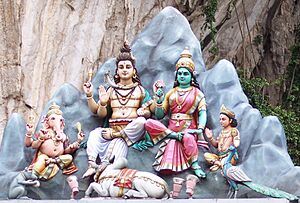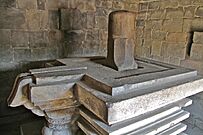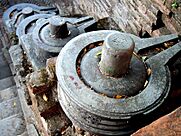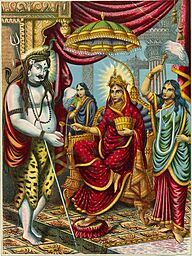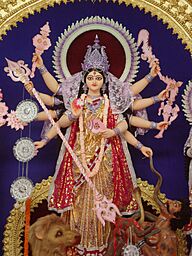Parvati facts for kids
Quick facts for kids Parvati |
|
|---|---|
| Mother Goddess Goddess of Power, Nourishment, Devotion, Motherhood, Fertility, and Harmony Supreme Goddess in Shaivism |
|
| Member of Tridevi and Pancha Prakriti | |
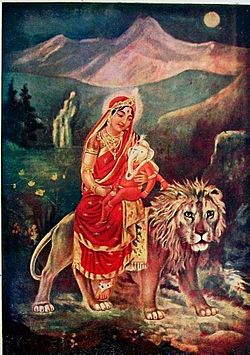
Parvati with her son Ganesha
|
|
| Other names | Uma, Gauri, Durga, Kali, Aparna, Girija, Haimavati, Ambika, Bhavani, Meenakshi, Kamakshi, Annapoorna, Visalakshi, Katyayani, Bhavani, Mahadevi, Akilandeshwari |
| Devanagari | पार्वती |
| Affiliation | |
| Abode | Kailasha, Manidvipa |
| Mantra | Sarvamaṅgalamāṅgalye Śive Sarvārthasādhike । Śaraṇye Tryambake Gauri Nārāyaṇi Namo'stu Te ।। |
| Day | Monday & Friday |
| Mount | Lion and Tiger |
| Texts | Devi-Bhagavata Purana, Mahabhagavata Purana, Devi Mahatmya, Kalika Purana, Shakta Upanishads, Tantras |
| Festivals |
|
| Personal information | |
| Consort | Shiva |
| Children | |
| Parents | Himavan (father) Maināvati (mother) |
| Siblings | Ganga (elder sister) Mainaka (elder brother) |
Parvati is a very important goddess in Hinduism. She is also known by other names like Uma and Gauri. People see her as the goddess of power, energy, love, beauty, and motherhood. She is also linked to harmony and nourishment.
Parvati is part of a special group called the Tridevi. This group includes Lakshmi and Sarasvati. She is the main wife of the god Shiva. Parvati is seen as the energy that gives Shiva his power. Without her, Shiva is not complete.
In old Indian stories, Parvati is shown as the perfect wife and mother. She is the mother of two well-known Hindu gods: Ganesha and Kartikeya. Some stories also say she is the younger sister of Lord Vishnu. Parvati is also a main goddess in a Hindu group called Shaktism, which focuses on goddesses.
Contents
What Parvati Looks Like
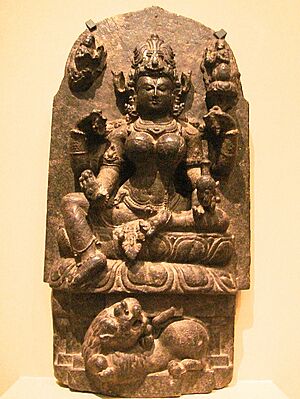
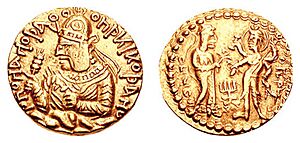
Parvati is usually shown as beautiful and kind. She often wears a red dress, like a sari, and sometimes a headband. When she is with Shiva, she usually has two arms. But when she is shown alone, she might have four arms.
These hands can hold different things. She might hold a trident, a mirror, or a string of beads. Sometimes she holds a bell, a dish, or a flower like a lotus. One of her front hands might be in the Abhaya mudra. This is a hand gesture that means 'don't be afraid'. Often, one of her children, usually Ganesha, sits on her lap. Her younger son, Skanda, might be playing nearby. In old temples, Parvati's statues are often seen near a calf or a cow.
Parvati's statues are mostly made from bronze. Stone is also a common material for her sculptures. Sometimes, Parvati is shown with golden or yellow skin. This is especially true when she is called goddess Gauri. This color shows she is the goddess of ripe harvests.
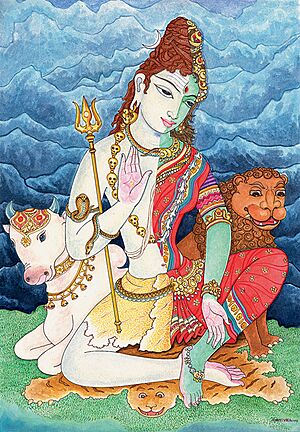
Festivals and Celebrations
Teej Festival
Teej is a very important festival for Hindu women. It is celebrated mostly in northern and western India. Parvati is the main goddess honored during this festival. It celebrates married life and family bonds. It also marks the monsoon season.
During Teej, people hang swings from trees. Girls play on these swings, often wearing green dresses. They sing traditional songs. In the past, unmarried girls prayed to Parvati to find a good husband. Married women prayed for their husbands' well-being. They also visited their relatives. In Nepal, Teej lasts for three days. People visit Shiva-Parvati temples and make offerings. Teej is also known as Teeyan in Punjab.
Gowri Habba
The Gowri Habba, or Gauri Festival, is celebrated for three days. It happens on the seventh, eighth, and ninth days of Bhadrapada (a Hindu month). Parvati is worshipped as the goddess of harvest. She is also seen as the protector of women. This festival is mainly for women. It is celebrated close to the festival of her son Ganesha, called Ganesh Chaturthi. This festival is popular in Maharashtra and Karnataka.
Navratri is another popular festival for Parvati. During this festival, all her different forms are worshipped over nine days. It is very popular in eastern India, especially in Bengal, Odisha, Jharkhand, and Assam. It is also celebrated in other parts of India, like Gujarat. People worship her nine forms, including Shailaputri, Brahmacharini, and Durga.
Other Festivals
Another festival called Gauri Tritiya is celebrated for about a month. It is popular in Maharashtra and Karnataka. Women in the household set up platforms in a pyramid shape. They place an image of the goddess at the top. Below it, they put ornaments, images of other gods, and shells. They invite neighbors and give them gifts like turmeric, fruits, and flowers. At night, they pray, sing, and dance.
In southern Indian states like Tamil Nadu and Andhra Pradesh, the Kethara Gauri Vritham festival is celebrated. It happens on the new moon day of Diwali. Married women fast for the day. They prepare sweets and worship Parvati for their family's well-being.
Thiruvathira is a festival in Kerala and Tamil Nadu. It is believed that on this day, Parvati met Shiva after a long time of prayer. Shiva then took her as his wife. On this day, Hindu women perform a dance called Thiruvathirakali. They sing folk songs about Parvati and her love for Lord Shiva.
Parvati in Arts and Coins
Arts
Many Indian art forms tell stories about Parvati and Shiva. These include sculptures and dance. For example, Daksha Yagam is a Kathakali dance-drama. It shows the romantic stories of Parvati and Shiva.
The Gauri-Shankar bead is a religious item. It comes from the belief that Parvati and Shiva are two equal halves that complete each other. A Gauri-Shankar is a special bead called a rudraksha. It grows naturally from a tree in India. Sometimes, two seeds from this tree grow together. These fused seeds are seen as symbols of Parvati and Shiva. People wear these beads in necklaces or use them for meditation.
Ancient Coins
Old coins from Bactria (Central Asia) and from King Harsha (North India) show Uma (Parvati). These coins were made between the 3rd and 7th centuries AD. On coins from Bactria, Uma is spelled Ommo. She is shown holding a flower. Shiva is also on these coins. He is sometimes shown with a trident and standing near Nandi, his bull. On coins from King Harsha, Parvati and Shiva are sitting on a bull. The back of the coin has ancient Indian writing.
Important Temples
Parvati is often found with Shiva in Hindu temples. These temples are all over South Asia and Southeast Asia. Some places, called Pithas or Shaktipeeths, are very special. This is because of their history and old stories in Hindu texts.
List of Temples
Each major Parvati-Shiva temple is a place where people go on pilgrimages. Each temple has an old story linked to it. These stories often connect many Hindu temples across South Asia. Some temples where you can find Parvati include:
- in Jammu and Kashmir: Mantalai Temple and Gauri Kund in Udhampur District, Jammu
- In Karnataka: Chamundeswari Temple in Mysore
- In Odisha: Parvati as Annapurna in the Lingaraj temple complex, Bhubaneswar, and Birja Temple in Jajpur
- in Kerala: Annapurneshwari Temple, Cherukunnu, Attukal Bhagavathy Temple, Chakkulathukavu Temple, Chengannur Mahadeva Temple, Oorpazhachi Kavu, Irumkulangara Durga Devi Temple, Chakkulathukavu Temple, Kadampuzha Devi Temple, Mridanga Saileswari Temple, Kumaranallor bagavathi temple and most of 108 durgalayas in Kerela
- in Maharashtra: Tulja Bhavani Temple
- in Meghalaya: Nartiang Durga Temple
- in Tamil Nadu: Meenakshi Amman Temple, Kamakshi Amman Temple, Sri Siva Durga Temple, Bannari Amman Temple, Samayapuram Mariamman Temple, Vekkali Amman Temple, Mutharamman Temple, Kulasekharapatnam, Tiruverkadu Devi Karumariamman Temple, Nellaiappar Temple, Kapaleeshwarar Temple, Masani Ammam temple, Gomathi Amman, Punnainallur Mariamman
- in Tripura: Tripura Sundari Temple
- in Uttar Pradesh: Vishalakshi Temple, Annapurna Devi Temple, Alopi Devi Mandir
Images for kids
-
Parvati being celebrated at the Gauri Festival in Rajasthan.
See also
 In Spanish: Parvati para niños
In Spanish: Parvati para niños


